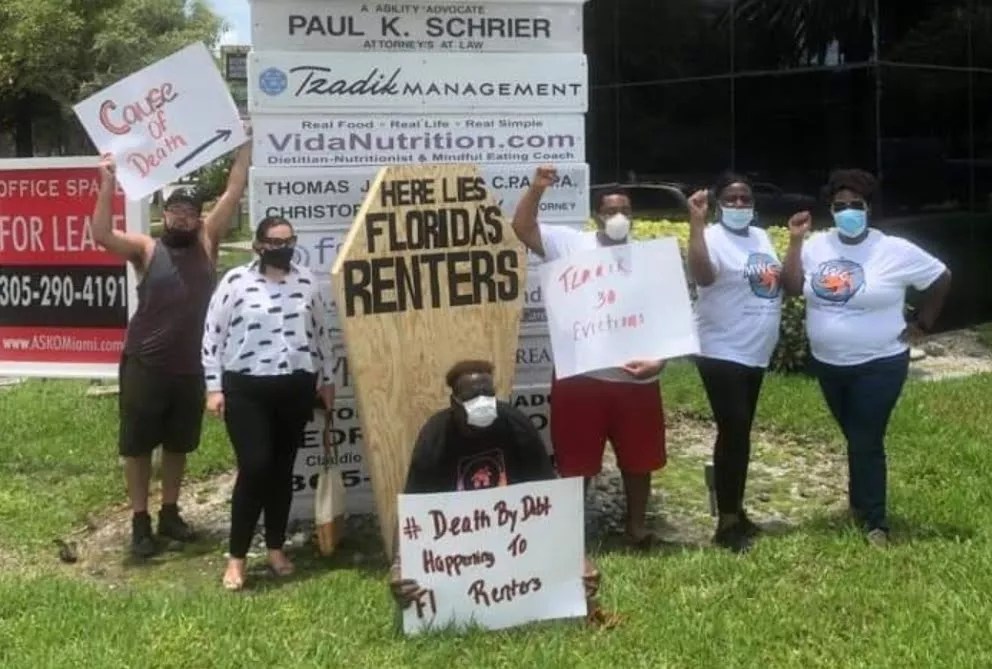
Photo by Struggle for Miami’s Affordable and Sustainable Housing (SMASH)

Audio By Carbonatix
More than a year after the pandemic era evictions moratorium expired, Miami-Dade County is beginning to experience evictions on a scale beyond what it faced before COVID-19, when comparing the figures on a year-over-year basis.
The county’s Office of the Commission Auditor just released its second quarterly evictions and foreclosures report for 2022, which shows a heavy influx of eviction cases pouring into county court. The report contains data from April to June of this year.
The report shows that, when compared to the same month in 2021, evictions increased by 45 percent in June, 52 percent in April, and a staggering 84 percent in May. June had the highest number of evictions filed for the quarter at 1,599. Though there was a steady uptick from April to June, eviction figures are lower than what the county saw in March of this year, when landlords filed 1,657 evictions in one month.

The number of eviction cases filed in Miami-Dade County from 2018 to 2022
Screenshot from Miami-Dade County Office of the Commission Auditor
The federal government, Miami-Dade County, and the State of Florida restricted evictions during the COVID-19 pandemic to help those who were financially impacted. While a federal moratorium enacted by the Centers for Disease Control and Prevention persisted into the summer of 2021, it didn’t halt eviction filings: Landlords were still able to file their eviction cases, though the eviction process would be held up in court if a tenant submitted a declaration of hardship and income loss.
As the statistics show, eviction filings continued throughout the worst days of the pandemic in South Florida, with the onus on renters to submit their declarations or defend themselves against landlord proceedings.
The number of evictions in Miami-Dade has increased steadily since the summer of 2021, now surpassing even pre-pandemic levels from 2018 and 2019 when comparing the corresponding months. For instance, 1,548 evictions were filed this May, compared to 1,475 in May 2018, and 1,399 in May 2019.
Annie Lord, executive director of Miami Homes For All, has been following eviction trends in Miami as the county grapples with an ongoing housing crisis amid rising costs of living. Lord tells New Times there is a clear correlation between the steady rise in evictions and steep rent increases throughout the county.
“The reality is we’re seeing a huge rent increase play out, so it’s not surprising that evictions are still high,” Lord says.
Many of the evictions have been filed in areas populated by predominantly minority residents.
The zip codes that experienced some of the highest numbers of eviction filings included areas like Overtown, Brownsville, Allapattah, and North Miami, where predominantly Black and Hispanic residents live. Miami-Dade County Commission District 3, overseen by Commissioner Keon Hardemon, had 21 percent of the county’s total pending eviction cases for the quarter, the greatest share by far.
Lord says housing advocates are aware that the majority of evictions are happening in lower-income minority communities.
“One of the existential threats we face is that when you have such massive displacement of lower-income folks who don’t have places to go, they end up on the street. That will impact all of us,” she says.
Notable, however, is 33132, which includes part of downtown Miami near from Bayfront Park to Margaret Pace Park. This area is majority white non-Hispanic, according to data from MiamiDadeMatters.org, and had 189 pending eviction cases as of June, one of the highest shares in the report.
The second quarter also saw a steady increase in residential foreclosures filed in Miami-Dade County court, with a total of 2,213 pending foreclosure cases as of June. More than 800 were filed from April to June of 2022. Though more foreclosures were filed in the corresponding time periods in 2018 and 2019 than in the most recent quarter, the number of foreclosures in the county has doubled year-over-year since last summer.